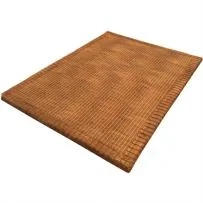What Is the Appearance of an Overlock Stitch in Sewing Techniques
Understanding Overlock Stitch A Guide to Its Appearance and Applications
When it comes to sewing, understanding various stitches is essential for both amateur crafters and professional tailors alike. Among these, the overlock stitch stands out for its unique appearance and functionality. But what does an overlock stitch look like, and how is it applied in sewing projects? This article aims to illuminate the characteristics of the overlock stitch and its prevalent uses in garment construction.
What is an Overlock Stitch?
An overlock stitch is a type of stitch used typically in overlock sewing machines, also known as sergers. This stitch is designed to finish the edges of fabric to prevent fraying while simultaneously sewing seams. Unlike traditional straight stitches, overlock stitches are characterized by their multi-thread composition, which creates a distinctive look that resembles a zigzag.
Visual Characteristics
The most defining feature of an overlock stitch is its multi-threaded structure. Typically, an overlock stitch employs three to five threads, which intersect in a particular way to form loops around the fabric edges. The appearance can vary slightly depending on the specific settings of the overlock machine and the stitch type selected, but generally, it consists of
1. Curved, Looping Edges The threads wrap around the fabric edges, creating gentle loops that provide a clean finish. 2. Tensioned Threads A properly executed overlock stitch maintains balanced tension across the threads, resulting in a smooth, even appearance. If the tension is improper, the stitch may look distorted or loopy.
3. Width Variations The width of the overlock stitch can be adjusted on the machine, allowing for narrow or wide finishes. A narrow overlock may resemble a tight zigzag, while a wider finish can give a more decorative effect.
4. Understitching When looked at from the underside, an overlock stitch creates a flat seam that is neat and often less bulky than traditional sewing techniques. The underside may show different thread colors if different threads are used, adding an element of visual interest.
what does overlock stitch look like

Applications of Overlock Stitch
The primary function of the overlock stitch is to create a professional and durable finish for garments. Its uses include
- Finishing Raw Edges One of the most common applications is to finish the seams of knit fabrics, which are prone to fraying. Overlocking locks the fabric edges, preventing them from unraveling over time.
- Seaming Knits and Stretch Fabrics Overlock stitches are flexible, allowing for movement in garments made from stretchy materials. This quality makes them ideal for t-shirts, leggings, and other activewear.
- Layering Fabrics For fabric layers that require a clean finish on edges, overlocking can secure multiple fabric layers simultaneously, streamlining the sewing process.
- Decorative Edges With various stitch types available, the overlock stitch can also serve a decorative function. Depending on the thread colors and stitch width, it can enhance the visual appeal of hems and seams.
Conclusion
In conclusion, the overlock stitch is a versatile and essential sewing technique renowned for its distinct appearance and practical applications. Whether you are a beginner learning to sew or an experienced tailor perfecting your craft, understanding what an overlock stitch looks like and how it can be effectively employed is crucial. From finishing raw edges to adding decorative flair, the overlock stitch is a valuable tool in any sewing arsenal. As you explore the world of sewing, mastering this stitch will undoubtedly elevate the quality of your projects, providing not only a professional look but also durability in your creations.
-
Boost Production Efficiency with a Pattern Sewing MachineNewsAug.29,2025
-
Industrial Excellence with the Best Heavy Duty Sewing MachineNewsAug.29,2025
-
Precision and Power with the Best Pattern Sewing MachineNewsAug.29,2025
-
Reliable Bulk Packaging Starts With the Right FIBC Sewing MachineNewsAug.29,2025
-
Advanced Packaging Solutions: Elevate Productivity with Jumbo Bag Sewing Machine and Industrial Stitching EquipmentNewsAug.29,2025
-
High-Performance Solutions for Bulk Packaging: FIBC Sewing Machine and MoreNewsAug.29,2025
-
Maximize Efficiency with an Industrial Cylinder Arm Sewing MachineNewsAug.28,2025


























